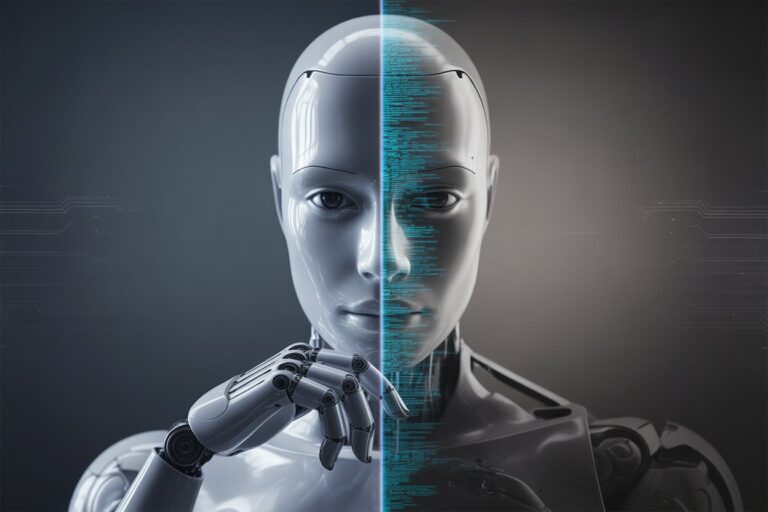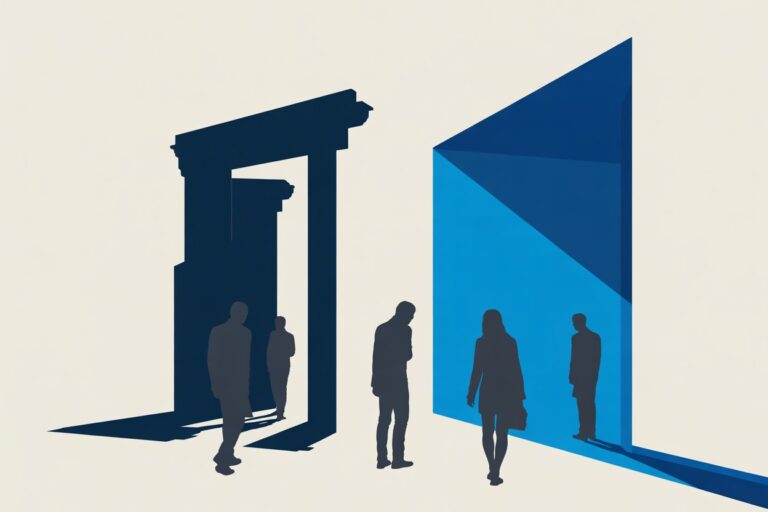Illinois’ BIPA Privacy Law Now Determines What AI Evidence Courts Will Accept
Every time a law firm uploads a video deposition to an AI transcription service, analyzes surveillance footage with facial recognition software, or uses biometric authentication to access case files, Illinois’ Biometric Information Privacy Act creates potential liability and a new battleground for evidence admissibility. What began in 2008 as protection for fingerprint time clocks has become a gatekeeper determining whether AI-generated evidence can enter American courtrooms.
AI Training Data Creates Legal Liability Crisis
The Illinois Biometric Information Privacy Act, enacted in 2008 under 740 ILCS 14, requires written notice and informed consent before private entities can collect biometric identifiers including fingerprints, facial geometry, iris scans, and voiceprints. When AI vendors scrape faces from social media, harvest voiceprints from uploaded videos, or purchase biometric datasets from third parties without verifying consent, they potentially violate BIPA and contaminate their models.
Legal AI is particularly vulnerable. Systems used for e-discovery, document analysis, and case prediction increasingly process video depositions, surveillance footage, and recorded interviews, all containing biometric data. If the underlying training data or the processed content involves Illinois residents and lacks proper BIPA consent, opposing counsel now has grounds to challenge not only privacy compliance but also the admissibility of the evidence itself.
The intersection of AI development and biometric privacy has created what practitioners call the “provenance problem.” When AI blends data from hundreds of sources, establishing that none violated privacy statutes becomes increasingly difficult. This challenge extends beyond Illinois. In December 2024, the Department of Justice issued a final rule implementing Executive Order 14117, restricting bulk transfers of Americans’ sensitive personal data, including biometric identifiers, to foreign adversaries. The rule defines biometric identifiers broadly to include facial images, voiceprints, iris scans, and behavioral data such as gait and keystroke patterns.
How BIPA Is Reshaping AI Evidence Law
The 2023 Illinois Supreme Court decision in Cothron v. White Castle System, Inc. transformed BIPA from compliance obligation to existential threat. The Court ruled that each biometric scan constitutes a separate violation, potentially exposing White Castle to $17 billion in statutory damages for employee fingerprint time clocks. While the Illinois legislature enacted Senate Bill 2979 in August 2024 to limit accrual, defining multiple scans of the same person as a single violation, the amendment did not eliminate liability. Companies still face up to $5,000 per person for intentional violations, and with class actions encompassing thousands of employees or customers, exposure remains severe.
For legal AI, the calculus is more complex. Following the Illinois Supreme Court’s 2019 decision in Rosenbach v. Six Flags Entertainment Corp., which held that plaintiffs need not prove actual harm to sue under the state’s Biometric Information Privacy Act (BIPA), litigation exploded. Legal analysts estimate that more than 2,000 BIPA lawsuits have been filed since Rosenbach, as courts affirmed that technical violations alone confer standing. The result, according to the Washington Legal Foundation, is “no-injury” biometric privacy litigation that has opened the floodgates and made Illinois home to the nation’s most aggressive biometric privacy regime.
This litigation wave now extends beyond employers to AI vendors. In 2024, Texas Attorney General Ken Paxton secured a record $1.4 billion settlement from Meta for violations of Texas’s biometric privacy statute, dwarfing Meta’s earlier $650 million BIPA settlement with Illinois plaintiffs. Google settled BIPA claims for $100 million, Snapchat for $35 million, and TikTok for $92 million. The message is unambiguous: biometric privacy enforcement has become a multi-billion-dollar liability with nationwide reach.
When Privacy Violations Undermine Evidence Admissibility
Courts are beginning to scrutinize the intersection of AI evidence and biometric privacy. Under Rule 901 of the Federal Rules of Evidence, parties must authenticate evidence as genuine. When AI generates analysis from biometric data, such as facial recognition matches, voiceprint identification, or gait analysis, authentication increasingly requires proof that the underlying data collection complied with applicable privacy laws.
Consider three scenarios unfolding in litigation today. First, a personal injury plaintiff uses AI-enhanced surveillance footage showing the defendant’s employee at the scene. Defense counsel demands in discovery documentation proving the AI vendor obtained BIPA-compliant consent from all individuals whose facial geometry was analyzed. Without it, the evidence faces exclusion as unlawfully obtained. Second, an employment dispute involves AI-generated attendance records based on biometric time clocks. If the employer never secured written BIPA releases, the plaintiff attacks both the privacy violation and the evidentiary reliability, arguing that data collected unlawfully cannot form the basis for credible proof. Third, a criminal defense attorney moves to suppress facial recognition evidence, demonstrating that the law enforcement AI tool was trained on datasets scraped from social media without BIPA consent.
Commentators writing in legal publications observe that courts may treat AI outputs as inadmissible if the training data included biometric identifiers collected unlawfully, breaking the chain of custody that traditional evidence law requires. The challenge extends to establishing data provenance across complex AI systems that aggregate information from multiple sources.
Discovery as Enforcement Mechanism
Plaintiffs’ attorneys have weaponized BIPA through discovery. When corporations deploy AI systems for human resources, security, or customer analytics, opposing counsel now routinely demands written policies governing biometric data collection, vendor contracts showing BIPA compliance obligations, consent forms signed by employees or customers, data retention and destruction logs, and documentation proving that AI training data excluded Illinois residents’ biometric identifiers collected without consent.
Law firms face parallel exposure. Using AI-powered e-discovery tools that analyze video depositions triggers BIPA obligations if the system extracts facial geometry or voiceprints from Illinois witnesses. Uploading client documents containing biometric data to AI vendors that reserve training rights may constitute unauthorized disclosure. The Federal Trade Commission warned that repurposing biometric data for AI training without notice may violate Section 5 of the FTC Act, a warning BIPA plaintiffs have cited in civil litigation.
BIPA exempts government agencies from direct liability, but the statute applies to private vendors who build and train the AI systems law enforcement uses. In 2022, facial recognition company Clearview AI reached a settlement that banned it from selling access to its database to any entity in Illinois, including state and local police, for five years.
The 2024 Regulatory Convergence
Multiple regulatory developments in 2024 signal that BIPA’s principles are becoming national AI governance standards. In May 2024, Colorado amended its consumer privacy law to require informed consent for biometric data collection and restrict employer use of biometric identifiers. In December 2024, the Department of Justice issued a final rule implementing Executive Order 14117, restricting bulk transfers of Americans’ sensitive personal data, including biometric identifiers, to foreign adversaries. The rule defines biometric identifiers broadly to include facial images, voiceprints, iris scans, and behavioral data such as gait and keystroke patterns.
The Consumer Financial Protection Bureau released Circular 2024-06 in October 2024, requiring that employment decisions based on biometric information, including AI analysis of keystroke frequency, driving habits, or worker behavior, comply with the Fair Credit Reporting Act. Employers must obtain consent and provide transparency about algorithmic assessments derived from biometric data.
Standards bodies are moving faster than legislatures. The ISO/IEC 42001:2023 artificial intelligence management standard and the NIST AI Risk Management Framework emphasize data provenance, transparency, and minimization, principles mirroring BIPA’s consent and retention requirements. Courts may soon view adherence to these frameworks as evidence of due diligence under state privacy laws, making compliance both a liability shield and an admissibility requirement.
Practical Implications for Legal Technology
Legal AI vendors now face a multi-layered compliance burden. They must audit training data sources to ensure no biometric identifiers were collected from Illinois residents without BIPA consent, a nearly impossible task for models trained on web-scraped datasets. They must implement consent mechanisms before processing any client matter involving Illinois parties. They must maintain detailed documentation showing data provenance to survive discovery. And they must offer indemnification to law firm clients, significantly increasing costs and insurance premiums.
For legal practitioners, BIPA creates both risk and opportunity. Risk: using AI tools that process biometric data without verifying vendor compliance exposes firms to malpractice claims and evidence exclusion. Opportunity: aggressive discovery into opponents’ AI systems can reveal BIPA violations that undermine their evidence and create settlement leverage.
Insurance and Risk Management: Professional liability carriers are beginning to scrutinize law firms’ use of AI tools that process biometric data. Firms should review their errors and omissions policies to determine whether BIPA violations by third-party vendors are covered. Some insurers now require specific representations about AI vendor due diligence before issuing or renewing coverage. The cost of comprehensive cyber liability and technology errors and omissions insurance has increased substantially for firms that handle biometric data or use AI tools in litigation support.
Vendor Certification and Due Diligence: Law firms should implement rigorous vendor assessment processes for any AI tool that may process biometric data. This includes requesting certifications of BIPA compliance, reviewing vendor security audits, examining data processing agreements for liability allocation, and requiring vendors to maintain detailed logs of data sources and consent documentation. Some firms are beginning to require vendors to obtain third-party BIPA compliance certifications before onboarding.
The practical questions multiply. Can a litigant use AI to analyze opposing parties’ social media photos if that analysis extracts facial geometry from Illinois residents without consent? Must courts conducting remote proceedings via Zoom obtain BIPA releases before AI transcription services process participants’ voiceprints? If a corporation’s AI-powered security system lacks BIPA compliance, can employees challenge not just the privacy violation but also any employment decisions based on the resulting data?
The Admissibility Question Courts Must Answer
The core legal question remains unresolved: does AI evidence generated from biometric data collected in violation of BIPA fail authentication requirements under Rule 901? Several arguments suggest courts may answer yes. First, evidence obtained through unlawful means traditionally faces exclusion to deter future violations and preserve judicial integrity. Second, BIPA’s legislative purpose, protecting individuals’ irreplaceable biometric identifiers, parallels the exclusionary rule’s aim of deterring constitutional violations. Third, allowing AI evidence derived from BIPA violations would create perverse incentives. Companies could profit from unlawful data collection by monetizing the resulting AI capabilities in litigation.
Counterarguments exist. BIPA is a civil statute, not a constitutional provision, and exclusionary rules typically require constitutional violations or specific statutory authorization. The statute’s private right of action provides a remedy of monetary damages, suggesting the legislature did not intend evidence exclusion as an additional sanction. And excluding AI evidence based on training data provenance could make vast categories of digital proof inadmissible, potentially paralyzing modern litigation.
The December 2024 DOJ rule on bulk sensitive personal data transfers signals that federal policy is moving toward treating biometric data as requiring heightened protection. As more jurisdictions adopt comprehensive privacy laws treating biometric data as sensitive information, the admissibility question will force judicial resolution.
Why This Matters Now
BIPA has evolved from consumer protection statute to fundamental constraint on AI deployment. Its requirements – notice, consent, retention limits, prohibition on profit – now function as preconditions for evidence admissibility. The August 2024 amendment limiting per-person damages did not eliminate this dynamic. It merely capped financial exposure while leaving the underlying compliance obligations and evidentiary implications intact.
Three factors make BIPA particularly significant for legal AI moving forward. First, the statute applies regardless of where the AI vendor is located. Processing biometric data from Illinois residents triggers jurisdiction. Second, the private right of action means thousands of individual plaintiffs and class action attorneys are actively policing compliance, creating enforcement far more aggressive than regulatory agencies alone could achieve. Third, the technical violation standard established in Rosenbach means companies cannot avoid liability by arguing no one was harmed. The mere lack of consent suffices.
Every legal AI system that processes video depositions, analyzes photographs, transcribes audio recordings, or authenticates users through biometric identifiers must now answer: where did the training data come from, and can we prove it was lawfully collected? Failure to document satisfactory answers creates litigation risk, but more fundamentally, it threatens the admissibility of AI-generated evidence in any matter involving Illinois parties.
BIPA was written for a world of fingerprint scanners at the factory gate. It now governs the machine learning models reshaping legal practice. The statute’s text remains unchanged since 2008, but its application has expanded to reach technologies its drafters never imagined. This is not a distant regulatory concern. It is the live question determining which AI evidence courts will accept and which they will exclude in cases being filed today.
Sources
- ACLU of Illinois: Biometric Information Privacy Act (BIPA)
- ACLU of Illinois: Rosenbach v. Six Flags
- American Bar Association: How the 2024 BIPA Amendments Affect AI Use (June 2024)
- American Bar Association: Illinois Supreme Court Finds White Castle Could Face Up to $17B in Damages (May 2023)
- Cothron v. White Castle System, Inc., 2023 IL 128004
- Department of Homeland Security: Biometrics
- Department of Homeland Security and Department of Justice: Biometric Technology Report (December 2024)
- Department of Justice: Data Security Program Final Rule (December 2024)
- Department of Justice: Artificial Intelligence and Criminal Justice Report (December 2024)
- Federal Trade Commission: AI Companies and Terms of Service Guidance (February 2024)
- Government Technology: Google $100 Million BIPA Settlement (September 2022)
- Hunton Andrews Kurth: TikTok $92 Million Settlement (July 2022)
- Illinois General Assembly: Senate Bill 2979 (2024)
- Illinois General Assembly: Biometric Information Privacy Act, 740 ILCS 14 (2008)
- ISO/IEC 42001:2023 Artificial Intelligence Management System Standard
- KPMG: AI and Privacy – Biometric Tech & Data (January 2025)
- National Institute of Standards and Technology: AI Risk Management Framework (January 2023)
- TechCrunch: Snapchat $35 Million BIPA Settlement (August 2022)
- Texas Office of the Attorney General: $1.4 Billion Meta Settlement (July 2024)
This article was prepared for educational and informational purposes only. It does not constitute legal advice and should not be relied upon as such. All cases, statutes, settlements, and regulatory developments cited are based on publicly available sources including court filings, government reports, and reputable legal publications. Readers should consult professional counsel for specific legal or compliance questions related to AI use and biometric data privacy.
See also: Data Provenance Emerges as Legal AI’s New Standard of Care







